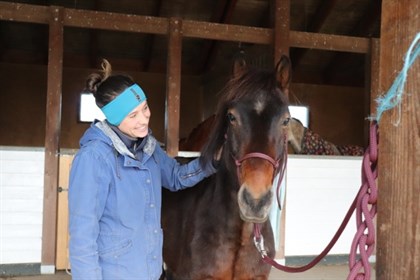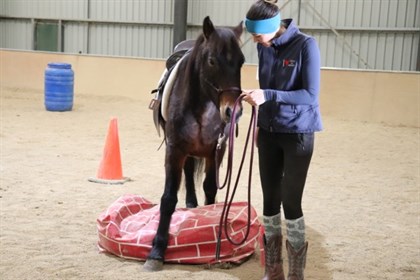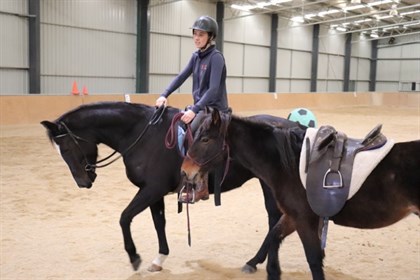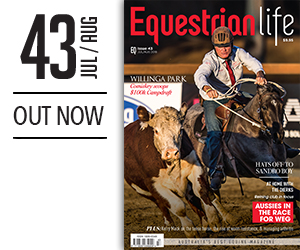
Being consistent - helps Cooper trust in Lara’s decisions as leader.
© Elsa Roberts
Missed Lara's first blog? Catch up here.
As discussed in my first blog, we must establish leadership before we can move forward with our training program. Horses naturally establish their role in the herd by knowing ‘who the leader is based on who moves whose feet.’ By introducing a language of cues that influence Cooper’s feet, I was able to naturally establish my role as the leader. This process is critical as he can now trust in my decisions to keep us both safe as we build on our relationship.
The first ten days was about using pressure and release to educate Cooper on where to place his feet. Time spent improving this practice is important - it provides clarity on how we communicate going forward.
Lara makes learning a new language fun.
© Elsa Roberts
Establishing leadership
As the leader, my role is to maintain consistency throughout so that Cooper knows what to expect from me. His confidence is growing each and every day. The success of our relationship is about being consistent in everything we do together. This applies to when I feed Cooper, introduce him to new objects, and performing our freestyle event at EQUITANA in November.
I use three simple principles:
• Moving the Feet – establishes my role as the leader.
• Pressure and Release - horses learn from the release of pressure.
• Mistakes and Opposites - allows a horse to make mistakes and then correct them by doing the opposite.
My daily mantra
I will constantly choose where and when Cooper moves his feet.
I will always give Cooper release of pressure when he attempts a correct response to a cue.
I will always allow Cooper to make mistakes before I correct him by doing the opposite.
To illustrate how I deal with a difficult situation
For the first few weeks getting Cooper to eat hard feed was quite a mission – wild horses don’t eat pellets! However, it wasn’t long before he became Low-GI Cube obsessed, where on a few occasions he was telling me to “get away from his food” with his ears back and jaw clenched. This behaviour created a challenging situation for me.
The answer, of course, is to stay calm; be consistent and stay true to my mantra. This example shows that he is trying to move my feet away from the food and establish his role as the leader. That’s okay, he’s allowed to make mistakes - but - instead of moving my feet, I must use pressure and release to ask him to move his feet. When he is gentle and calm, we’re able to resume the exercise of eating his dinner.
Having established these principles in the first week - we maintain consistency every time
The leading cues that Cooper learns on the ground, translate directly as he works alongside our lead horse Harry.
© Elsa Roberts
Learning the language
Speaking a common language enables us to communicate effectively with our horses. The challenge is to create a language that allows us to communicate with them.
In order to understand this method, we first need to consider the mind of the horse. Humans communicate with verbal language whereas horses naturally use body language. When we learn to establish a language of physical cues, we can bridge that gap. We build on our physical vocabularly by enlisting a series of words/cues that allow us to achieve more, grow together and to stay safe.
How to use a set of physical cues as our first language
The term we use to give our horse an instruction is a cue. A horse is able to understand some verbal cues but their natural method of communication is body language. The cue that I use to catch Cooper translates directly to a leading-cue in the halter, and easily translates to a cue in the bridle.
Our first month was about building a language of cues that he could understand. Cooper first had to learn how to move all four parts of his body - Head/Neck, Shoulders, Ribs, and Hindquarter. I think of these four components as a series of building blocks, where I train each part to move left, right, and sideways.
It’s all about Cooper learning the basics steps before we attempt the master formula. As Cooper graduates to the next level that sees him perform in multiple disciplines; he has already learnt the foundations which allow me to do things like: flex his head and neck, lift his shoulder, bend his rib and bring his hind-quarters forward. When the time comes to add all these steps together, the result equals a horse in a frame on a circle.
The key message here is about teaching each cue individually. This means that Cooper doesn't get stressed or feel anxious when we work together as he has learnt to trust in my decisions as the leader.
Lara Beth Poynton
For further updates go to: Brumbydiaries/Lara Beth
2018 Naming Rights Partner, McDowells Herbal Australian Brumby Challenge
EQUITANA Melbourne, 15 to 18 November
Missed Lara's first blog? Catch up here.
READ THE LATEST NEWS ARTICLES HERE
https://www.equestrianlife.com.au/articles/BLOG-Follow-the-leader-and-learning-language-skills_



